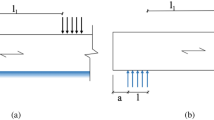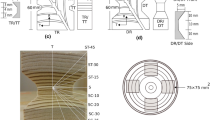Summary
This is the first of two papers designed to describe the most recent efforts in using contemporary technology to predict strength and failure location in wood poles. In this report, a three-dimensional finite element model is presented which was developed to provide a rational stress analysis tool for wood poles. Due to practical considerations, only critical pole segments were subjected to stress analyses. Twelve-inch (30.5 cm) segments were selected for analysis which contained knots or knot clusters deemed consequential.
The linear elastic model assumes small-deflection theory, and exploits linear strain, 15-node wedge and 20-node parallelepiped, isoparametric finite elements. Element geometry was selected to reflect knot size distribution found in full-size wood poles used in North America. Boundary conditions represented both applied loading and support considerations.
Model verification studies were conducted on poles with isotropic (steel) and anisotropic (wood) material properties with and without spiral grain and variable longitudinal elastic properties along the pole radius. The results showed excellent agreement between theoretical and numerically-predicted pole stresses. The effect of boundary conditions on predicted stress distribution was defined, and the element geometry was appropriately modified. The developed model proved to be a rational basis for a more enhanced version to predict the mechanical behavior of wood poles with several inherent growth characteristics.
Similar content being viewed by others
References
Al-Dabbagh, A.; Goodman, J. R.; Bodig, J. 1972: Finite element method for wood mechanics. Journal of the Structural Division, ASTM, 98(813): 569–586
American National Standards Institute —ABNT; 1987: Standard for Wood PolesSpecification and Dimensions for Wood Poles. ANSI 05.1-1987. NY
Associacao Brasileira de Normas Tecnicas — ABNT; 1984: Postes de Eucalyto Preservado para Redes de Distribuicao de Energia Electrica (Preserved Eucalypti Poles for Distribution Lines). Standard NBR-8456. Rio de Janeiro
Bodig, J.; Goodman, J. R. 1973: Prediction of elastic parameters for wood. Wood Science 5(4): 249–264
Bodig, J.; Jayne, B. A. 1982: Mechanics of Wood and Wood Composites. Van Nostrand-Reinhold Company, Inc. New York
Cramer, S. M.; McDonald, K. A. 1989: Predicting lumber tensile stiffness and strength with local grain angle measurements and failure analysis. Wood and Fiber Science 21(4): 393–410
Davalos-Sotelo, R.; Pellicane, P. J. 1992: Bolted connections in wood under bending/tension loading. Journal of Structural Engineering 118(4): 999–1013
Fun, Y. C. 1969: Foundations of Solid Mechanics. Prentice-Hall Inc. Englewood Cliffs, NJ.
Goodman, J. R.; Bodig, J. 1970: Orthotropic elastic properties of wood. Journal of the Structural Division, ASCE, 96(ST11): 2301–2319
Holzer, S. M.; Loferski, J. R.; Dillard, D. A. 1989: A review of creep in wood: concepts relevant to develop longtern behavior predictions for wood structures. Wood and Fiber Science 21(4): 376–392
Jayne, B. A. 1972: Theory and Design of Wood and Fiber Composite Materials. Syracuse University Press. Syracuse
Jayne, B. A.; Suddarth, S. K. 1966: Matrix-Tensor Mathematics in Orthotropic Elasticity. Orientation effects in the Mechanical Behavior of Anisotropic Structural Materials. ASTM STP 405, pp. 39–58
Pellicane, P. J. 1992: A finite element to model thin inhomogeneities in solids. Forest Products Journal 42(1) 50–52
Pellicane, P. J.; Franco, N. 1994: Modeling wood pole failure — part 2: material and geometric considerations. Wood Sci. Technol. 28: (in press)
Polensek, A. 1976 Finite element analysis of wood-stud walls. Journal of the Structural Division, ASCE, 102(ST7): 1317–1335
Suddarth, S. K. 1979: Truss Analysis — PPSA II. Proceedings of the Metal Plate Wood Truss Conference, 1979. Forest Products Research Society, Madison, WI
Thompson, E. G.; Goodman, J. R.; Vanderbilt, M. D. 1976: FEAFLO: a program for the analysis of layer wood systems. Computers and Structures, Vol. 7: 237–248
Wang, Y.; Bodig, J. 1990: Strength grading method for wood poles. Journal of Structural Engineering 116(11): 2952–2967
Zalph, B.; McLain, T. E. 1992: Strength of wood beams with filleted interior notches. Wood and Fiber Science 24(2): 204–215
Author information
Authors and Affiliations
Rights and permissions
About this article
Cite this article
Pellicane, P.J., Franco, N. Modeling wood pole failure. Wood Sci.Technol. 28, 219–228 (1994). https://doi.org/10.1007/BF00193330
Received:
Issue Date:
DOI: https://doi.org/10.1007/BF00193330




